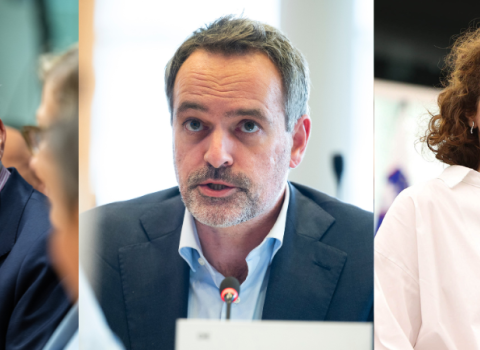Replacing Widening measures in the next Framework Programme with a separate scheme funded by cohesion money poses practical and philosophical problems, say members of central and eastern Europe’s research community

Christiansborg Palace in Copenhagen, the seat of the Danish parliament.
Government ministries and research stakeholders from central and eastern Europe say they are open to discussing the future of Widening measures but disagree with a suggestion by the Danish government that they be axed from the next Framework research programme, FP10.
Widening measures are intended to help close the east-west gap in research capabilities but the Danish government's position paper on FP10 describes them as “not optimal in terms of added value measured as widened participation”.
Instead of continuing Widening as part of FP10, a separate scheme should be set up and financed by, for example, regional cohesion funds, the paper says.
This suggestion is “not surprising”, said Ewa Kocinska-Lange, director of the Brussels office of Poland's National Centre for Research and Development.
Widening measures have been divisive since they were introduced in Horizon 2020. Several factions in Europe, mainly in western or northern states, see them as undermining the excellence principle. Denmark has often positioned itself in the ‘friends of excellence’ camp which views calls under the Widening scheme as less competitive, allowing grants to be awarded for lower quality research.
While she agrees with many points raised in the Danish paper, the excellence argument is “wrong by definition,” Kocinska-Lange said. “This is not a discussion about a lack of excellence,” […] We just think that excellence should be uncovered across all of Europe.” For the single European research area to work it is necessary to use Europe’s whole potential. “You cannot progress with just half,” she said.
Czechia is also strongly in favour of continuing the Widening measures under FP10, but would like to see a different focus and structure, with a shift from the ‘widening’ principle to an ‘empowering’ principle, a spokesperson for the Ministry of Education, Youth and Sports told Science|Business. “In other words, from ‘increased participation in the Widening measures’ of Widening countries to ‘better integration’ in the projects, including coordination of the projects,” the spokesperson said. “Stronger focus should be placed on research careers, management of research organisations and supportive structures.”
Similarly, Tadas Tumėnas, head of the Lithuanian RDI Liaison Office in Brussels, wants to see Widening measures spread across the different pillars of the framework programme so they work better at bringing excellent researchers into the wider programme, rather than keeping them penned into the Widening funds, or what he calls the “childs’ table”.
“Our focus should lie in integrating European world class research, regardless of the area it comes from,” he said. “That’s why we prioritise quality integration over a secondary tier funding pot. Having a two-speed Europe approach is not working.”
Bogdan Chelariu, head of the Brussels office for the North East Regional Development Agency of Romania, has watched on with frustration for several years as the question of the east-west research and innovation gap was pushed down the priority list. “I’m a bit disappointed. The Widening measures were not given a lot of attention in the past years,” he said. “In some ways, I agree with the Danish, the measures didn’t deliver. So the question is, what do we do?”
How effective have Widening measures been?
Widening was introduced in Horizon 2020 and in Horizon Europe the measures have a budget of just under €3 billion, with 15 countries eligible for calls.
A first real overview of the effectiveness of Widening is included in the evaluation of the 2014 - 2020 Horizon 2020 programme published last month.
It pointed to some positive effects. Participation in Widening countries increased compared to the previous framework programme, albeit modestly, and calls such as Twinning and Teaming, designed to further collaboration between Widening and non-Widening scientists worked well. The review found 28% of the highly cited papers by academics in Widening countries were linked to Widening actions, showing their influence.
But, the Commission’s review noted, “spreading scientific excellence in the EU deserves further attention.” The commissioner for research and innovation, Iliana Ivanova, said last week that challenges related to the Widening measures “still persist” under Horizon Europe.
Widening countries received an 8% share of the total EU contribution to Horizon 2020, a miserly amount considering their combined population accounts for 27% of the EU total.
Participants from Widening countries in Horizon 2020 accounted for 12.3% of the total, which is just 1.3% more than in FP7. About half of Widening funding went to just four countries, Portugal, Cyprus, Poland and Estonia.
Kamila Kozirog, policy analyst at the European University Association, said Widening instruments have been “helpful in providing opportunities to reduce disparities in access to the programme while preserving research excellence”, but more must be done.
“It is important to recognise that the research and innovation gap in Europe is yet to be effectively narrowed down and a significant innovation divide still exists across member states,” she told Science|Business.
The Horizon 2020 review does not paint the whole picture, given the Widening budget was tripled in Horizon Europe, and the full impact of projects funded in Horizon 2020 may not yet be evident. “You cannot expect the whole situation to change overnight,” Kocinska-Lange said. “This is a generation thing, a systemic thing. In Poland, you see some improvement in results.”
The Czech government spokesperson said there is a “clear, unquestionable positive added value of Widening measures on the Czech research and innovation ecosystem.” There has been “an increase of scientific excellence, internationalisation of Czech science and new collaborations, an increase in the number of projects coordinated by Czech entities, or the creation of excellent research teams that are often able to take up a leading role in Horizon Europe projects, to name just a few.”
Finding the right home
The Danish paper suggests funding Widening through the European Structural and Investment Funds (ESIF), four individual funds that aim to level up EU countries or regions in areas most in need. It has a budget of over €350 billion for the 2021 – 2027, distributed by Brussels to individual member states which then prioritise its spending. If R&D is not high on a country or region’s priorities, it will not receive focused funding.
This is one reason why many in central and eastern Europe’s research bubble are against putting Widening in the ESIF basket. “Alone, cohesion funds are not sufficient,” Tumėnas said. “We need an intervention at the EU level.”
A leading objective of Widening - to promote international collaborations between Widening and non-Widening partners - is not a fit with cohesion funds. In addition, being part of a pan-EU programme contributes to promoting excellence. “To get a researcher to be international, you need a European programme. It is important to internationalise more and Horizon Europe is a perfect tool for that,” Kocinska-Lange said.
The view from Czechia is the same. “Having Widening measures incorporated into the framework programme enables better connection and alignment between research calls, project consortia, etc,” the government spokesperson said. “We do not see any reason or any benefit why measures with a goal to lower the performance divide in research and innovation should be placed elsewhere than in the framework programme dedicated to the research and innovation.” Cohesion funds could be used to finance projects that miss the quality threshold at a European level but would still benefit the local country or region.
But with budgets everywhere in the EU being stretched thin, Chelariu says there is talk of going back to basics with cohesion funds and using them strictly for levelling up deprived regions. This would potentially remove or lower research and innovation investment via ESIF, leaving the question of closing the east-west research gap even further from being answered.
Chelariu would like to see Widening measures maintained in FP10 and research investments continued in cohesion funds, but he is pessimistic about the prospect of this being done well. “Honestly, I would say that I don’t think there is a genuine interest in solving this,” he said. “There are politicians who speak up for it, research groups who support it, some member states discuss it, but attempts to really close the gap are lacking.”
Marc Lemaître, the European Commission’s director general for research and innovation, said in June last year that Widening needs to be rethought, so changes for FP10 are likely.
“The problem is that even Widening countries can’t agree on the future of the measures,” Tumėnas said. The Danish paper is a starting point for a discussion.
Other member states are working on their own papers and some are expected to follow “the Danish approach” in lobbying for Widening measures to be funded through a different programme.
A more unified European position will be published by the European Research Area and Innovation Committee of member state representatives this June. One aspect that is agreed upon in Widening countries is the necessity for the EU to act together. “If we want to remain sovereign and secure […] Europe has to be one,” Tumėnas said.





 A unique international forum for public research organisations and companies to connect their external engagement with strategic interests around their R&D system.
A unique international forum for public research organisations and companies to connect their external engagement with strategic interests around their R&D system.